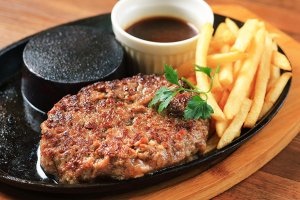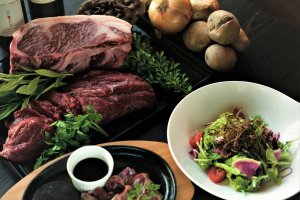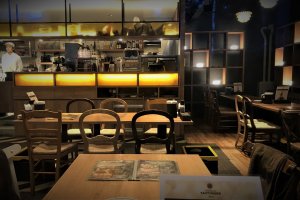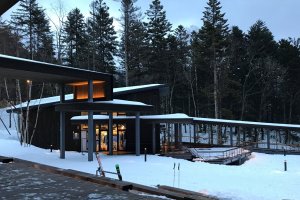When I first stepped inside this smart eatery I thought I could be in Reforma in Mexico City, with the stylized Aztec-looking black logo and the bright pastel colors being welcoming and appetizing for a long-awaited winter dinner.
Little did I know but Camaro is not a Spanish word, my limited knowledge of this Latin language failed me, but with both Japanese and Spanish being phonetic I could excuse myself for this faux pas.
Like Green Kitchen and many restaurants in Tomamu, their execution of European cuisine is as good if not better than their Japanese dishes, helped in no doubt by the proximity of farms specializing in various vegetables such as asparagus, potatoes, melons, and pumpkins, as well as beef and dairy.
The name Camaro comes from the merging of the words Camado and robata. Cama is a dome-like oven for cooking rice, an enclosed stove that is an essential part of traditional Japanese cooking. Robata on the other hand refers to charcoal cooking. Home is where the heath is, or so they say. Actually here the heath is so big, they called the restaurant after it. Imagine binchotan or the cured wood being coaxed to life at 200 to 400 degrees, making me hungry as I drool over the steak I will have tonight.
There are lots of family favorites served here, like Hokkaido wagyu steak and truffle French fries. This restaurant is all about letting the natural ingredients shine, instead of manipulating them to look or taste like something else.
The foie gras on baguette toast is a delightful way to start your meal here The foie gras has a creamy richness and an almost melt in your mouth texture, with just the right thickness to give enough bite, while the soy like gravy glaze locks in a juicy center. The baguette, on the other hand, is light and airy, its structure held together by a thin crispy crust.

The bocconcini and tomato salad highlight ripe Hokkaido produce, while the local Tokachi and Otaru wine represent many varieties despite its climatic conditions here, some tasting like Pinot noir. Recently, Hokkaido wines have won prizes with Cathay Pacific, demonstrating that years of hard work are paying off for this fledgling industry.
The raison d’être for this restaurant is its steak, on display at the entrance like the crown jewels in a palace. Start with the thick and juicy hamburger patties with a light and airy texture that crumbles away as you cut it, with a mild taste tempered by nutmeg. It is a real tribute to the chef here, to create a beef hamburger patty that is so tender yet crispy on the outside.

Step up to the Hokkaido Wagyu which comes in different cuts and sizes, starting with 150 grams. I tried the skirt steak which like all steaks here is served rare and then you can let it cook for as long or as short as you like on the hot stone, ensuring that you can cook your steak a bite at a time, ensuring that every bite is timed to perfection. They really know how to showcase the produce here, with just the right amount of beef taste and fatness, Of course, a little of the hand made barbecue or Japanese teppanyaki dipping sauce is very tempting, though I would avoid bathing the steak in the dipping sauce as it can be overpowering. This is your opportunity to experience the Kobu Black brand, with their Kuroge Wagyu or black-coat Japanese cow whose diet is supplemented with Hidaka seaweed and glutinous rice, decreasing the melting point of the fat and making it easier to taste the sweetness of beef. Other meat dishes include Tokachi Wagyu and Ezo venison.
For dessert, I tried the Spanish-inspired creme brûlée like flan, which when served looked like two slabs of butter, despite being dusted with icing sugar and a caramelized glaze. It had the texture of hard frozen butter, the kind that you can’t cut, let alone spoon over. Despite its light sunflower yellow color, it is very rich, so don’t let your eyes get the better of your tastebuds and take it tiny slivers at a time, you can really enjoy more of its deliciousness that way, letting its taste and texture dance on your tongue.

Despite the industrial-looking roof and the exotic Spanish-sounding items like Ajillo on the menu, the service is typically Japanese, polite, and kind as you would expect from Hoshino resort.




































In Kumamoto, Mandy writes about a restaurant called " Equipment Floor". https://en.japantravel.com/kumamoto/equipment-floor/5321
In Australia, there are many Thai restaurants with interesting names, like "Thai-Tanic".